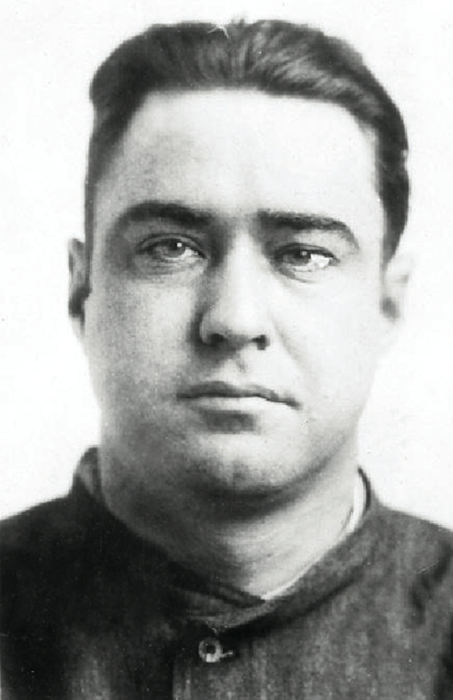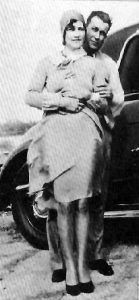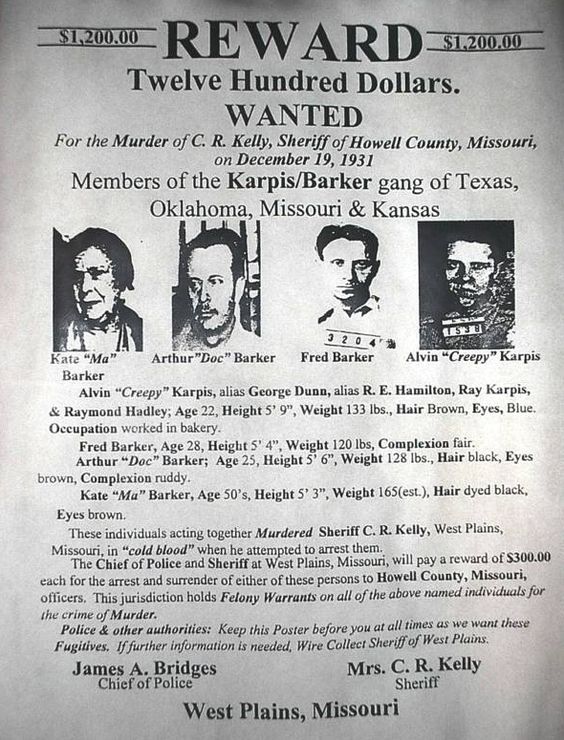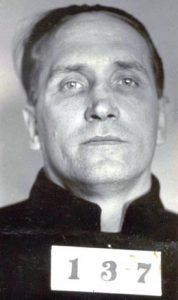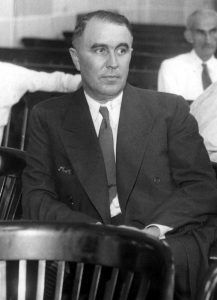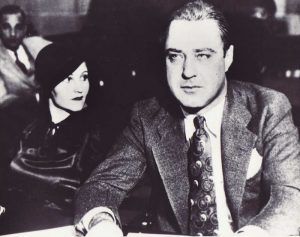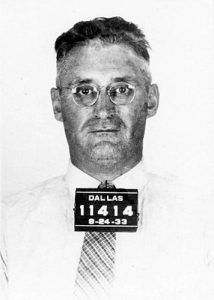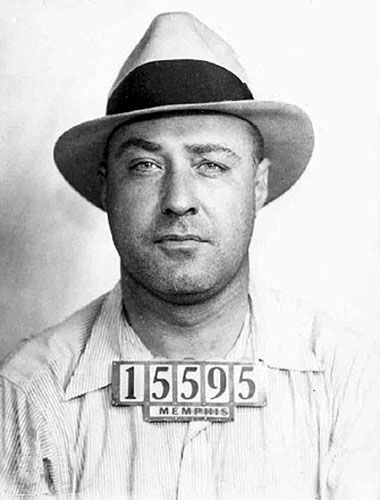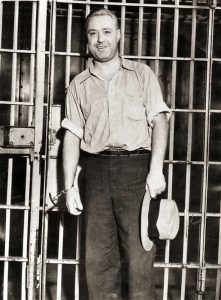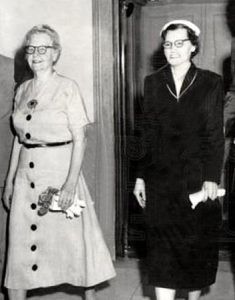“My family are good people. Only I turned out to be a heel.” — Machine Gun Kelly to Alcatraz Warden James A. Johnston
George Kelly Barnes, better known as “Machine Gun” Kelly, was a notorious Prohibition-era criminal whose crimes included bootlegging, armed robbery, and, most prominently, kidnapping. He spent some time in Alcatraz Prison in California before dying of a heart attack at Leavenworth Federal Prison in Kansas on July 18, 1954.
George Kelly Barnes was born on July 18, 1895, in Memphis, Tennessee, to insurance executive George Frederick Barnes Jr. and Elizabeth Kelly Barnes. He was raised in a respectable neighborhood and attended Central High School. In September 1917, he enrolled at Mississippi A&M (later Mississippi State University) in Jackson to study agriculture. However, he was a poor student and was in constant trouble with the faculty. In his first semester alone, he was given 31 demerits, and in the first few weeks of the second semester, he was given another 24 demerits. He left college on January 27, 1918. While in college, he met Geneva Ramsey, also of Memphis, and the two married in 1919. Afterward, he went to work as a taxi driver, and the couple had two children. His wife soon divorced him and would later say she divorced him “because he was running in bad company.” In fact, she had to advertise notice to get a divorce because she didn’t know where to reach him.
In the meantime, George began to operate as a small-time criminal, involved in moonshining and bootlegging. After a few arrests, he headed west and adopted the alias of George R. Kelly. He was again arrested for bootlegging in Santa Fe, New Mexico, on March 14, 1927. Convicted, he spent a few months in the New Mexico State Penitentiary. After his release, he went to Tulsa, Oklahoma, where he was arrested for vagrancy on July 24. He was arrested again in Tulsa for bootlegging on January 12, 1928.
Kelly then drifted to Oklahoma City, where he hooked up with bootlegger “Little Steve” Anderson. There, he also met Kathryn Thorne, Anderson’s attractive mistress. George and Kathryn soon developed a romance and ran off together, allegedly in Anderson’s Cadillac.
Kathryn, who had been married several times, was also involved in bootlegging and had a record of her own, including prostitution and theft. She was said to have been a “tough” woman who often frequented speakeasies, could “drink liquor like water,” and ran with a crowd of other tough women. Kathryn is said to have bought Kelly his first Thompson sub-machine gun, from which he earned the nickname “Machine Gun” Kelly. He became so proficient with the gun that he could write his name in lead and knock walnuts off a fence at 25 paces.
On January 13, 1928, Federal Prohibition agents caught Kelly smuggling liquor onto an Indian reservation. Kelly was tried in Federal Court in Tulsa, Oklahoma, and sentenced to three years in the Leavenworth Penitentiary in Kansas. He made his first real connections with the criminal underworld, such as Texas bank robber Charlie Harmon; Frank “Jelly” Nash, who was serving time for train robbery; and Francis Keating and Thomas Holden, who were also imprisoned for train robbery.
On February 28, 1930, Keating and Holden escaped prison and fled to Minneapolis, Minnesota. That same year, Kelly and Charlie Harmon were released and joined Keating and Holden. Also making her way north was Kathryn Thorne, and she and George Kelly were married in Minneapolis in September 1930.
The four men and several others, including Frank “Jelly” Nash and Harvey Bailey, became part of the Keating-Holden Gang. The gang then began a spree of robberies. They first robbed a bank in William, Minnesota, on July 15, 1930, making away $70,000. After a dispute led by Vern Miller, three of the gang members — Mike Rusick, Frank “Wennie” Coleman, and Samuel “Jew Sammy” Stein, were found shot to death at White Bear Lake. The gang then robbed a bank in Lincoln, Nebraska, on September 9, 1930, making off with $4,000,000. The gang continued to rob banks in Nebraska, Minnesota, and Wisconsin. Harmon was killed on November 19, 1931, following a $100,000 bank robbery with Holden and Keating at Menomonie, Wisconsin. Francis Keating and Thomas Holden joined with the Alvin Karpis-Barker Gang to rob a bank in Fort Scott, Kansas, on June 17, 1932. Keating and Holden were arrested a month later.
Kelly participated in some of the robberies and, at other times, lived with his wife, Kathryn, in Fort Worth, Texas. His list of underworld associates grew as he made his way from Texas to Kansas City, Chicago, and Minneapolis. He became acquainted with members of the “Kid Cann” syndicate in Minneapolis, with Chicago mobsters, with Alvin Karpis and the Barkers. His accomplices in various crimes included Eddie Bentz, Eddie Doll, and Albert Bates.
Machine Gun Kelly’s first venture into kidnapping occurred in South Bend, Indiana, on January 27, 1932. When Howard Woolverton, a local manufacturer and banker’s son, was driving home from a theater with his wife, another car forced them off the road. Two gunmen entered their car, and Howard Woolverton was ordered to drive out of town. Following the two gunmen was another vehicle. Two miles outside the city, one of the gunmen took Woolverton back to the vehicle that had followed and left his wife, Florence, with a note demanding $50,000 ransom. The kidnappers were George Kelly and Eddie Doll. After driving a blindfolded Woolverton around northern Indiana for two days, the victim finally convinced his kidnappers he could not pay the ransom. He was released on the outskirts of Michigan City, on his promise to raise the money later. Though Woolverton later received threatening letters and phone calls demanding the money, he ignored them.
Kelly then reverted to bank robbery. On September 21, 1932, Kelly, Albert Bates, and Edward Bentz robbed the First Trust and Savings Bank at Colfax, Washington, of $77,000. Warrants were issued for the trio, and Kelly’s home in Fort Worth was raided in November, but no one was at home. Eddie Bentz was arrested at the Dallas, Texas Post Office and admitted knowing Kelly and Bates but denied participating in the Colfax robbery. However, he told the police that Kelly and Bates often hid on a Texas farm but didn’t know the location. Bentz was released on bond and later fled.
On November 30, 1932, Kelly, Bates, Eddie Doll, and another man robbed the Citizens State Bank at Tupelo, Mississippi, of $38,000. Kelly and other criminals were also linked to bank robberies in Denton and Blue Ridge, Texas.
Next, George Kelly, his wife Kathryn, and fellow outlaw Albert L. Bates hatched a plan to kidnap wealthy Oklahoma oilman Charles F. Urschel. This would become Kelly’s most famous crime. It would also end his criminal career.
At 11:15 p.m., on Saturday, July 22, 1933, Mr. and Mrs. Charles F. Urschel played bridge with their friends, Mr. and Mrs. Walter R. Jarrett, on a screened porch of the Urschel residence at Oklahoma City. Two men, one armed with a machine gun and the other with a pistol, opened the screen door and inquired which of the two men was Mr. Urschel. Receiving no reply, they remarked, “Well, we will take both of them.” After warning the women against calling for help, they marched Urschel and Jarrett to their car and drove rapidly away. Mrs. Urschel immediately telephoned the FBI, and special agents were sent to Oklahoma City, where an extensive investigation commenced.
In the meantime, the victims had been driven to a point about 12 miles northeast of the city, and after the captives were identified, Jarrett was released. Jarrett returned to the Urschel residence at 1:00 a.m. on Sunday, July 23, 1933.
Several days elapsed before word was received from the kidnappers. Kelly and his gang wanted $200,000 for the oil tycoon and set up an elaborate system for handling their captive and delivering the ransom. The money was to be delivered to a hotel in Kansas City on July 30, which it was. The next day, the kidnappers let Urschel go. Urschel arrived home exhausted at about 11:30 p.m. on July 31. He was unharmed and, although blindfolded some of the time, he was able to provide several clues to authorities. From his descriptions, the FBI determined that he was held for days in two homes near Paradise, Texas. During this time, Urschel heard the voices of two men — one older and one younger — a woman- and his captors.
While the Bureau made no effort to apprehend the kidnappers until after the release of Urschel, an extensive investigation was being conducted. As early as July 24, two days after Urschel was kidnapped, information was obtained indicating the probability that George R. and Kathryn Thorne Kelly were involved in this crime. Consequently, an exhaustive investigation was commenced concerning the history and whereabouts of these individuals. The agents quickly determined that the Kellys enjoyed many luxuries, including high-powered automobiles and expensive jewelry, without any visible means of support.
After Urschel was debriefed, the Bureau’s activities centered on locating the houses in which Urschel was held and bringing about the apprehension and conviction of the kidnappers. The bureau soon discovered that Robert G. Shannon and his wife, Ora L. Shannon, Kathryn Kelly’s mother, lived near Paradise, Texas. It was also determined that Robert Shannon’s son, Armon Shannon, lived on a ranch about a mile and a half from his father.
After this information was obtained, the Shannon residence was raided early on August 12. Arrested was Harvey J. Bailey, a notorious criminal, and gunman, who had escaped from the Kansas State Penitentiary at Lansing, Kansas, on May 30, 1933. Robert, Ora, and Armon Shannon were also taken into custody. Harvey Bailey was discovered with a machine gun, two automatic pistols, and $1,100. The FBI soon determined that $700 of the money found on Bailey was used to pay ransom for Urschel’s release and that Kathryn Kelly purchased the machine gun in Fort Worth, Texas.
Charles Urschel could then identify the two houses as those in which he had been held. He also identified the Shannons as the people who had stood guard over him. After the Shannons were questioned thoroughly, they admitted that Urschel had been held at their residences and that George Kelly and Albert L. Bates had kidnaped him.
Albert Bates, a hardened criminal with a lengthy criminal record, was taken into custody in Denver, Colorado, on August 12, 1933, on a local charge. At the time of his arrest, he had in his possession $660, later identified by Bureau agents as part of the Urschel ransom money.
The serial numbers of the ransom bills were found to have been circulated to banks throughout the United States, many of which were located in Minneapolis, Minnesota. The bills were traced, and several “money-changers” were arrested.
On August 23, 1933, all of those that had already been arrested, plus George R. and Kathryn Thorne Kelly, were indicted at Oklahoma City, Oklahoma, on a charge of conspiracy to kidnap Charles F. Urschel.
On September 19, Charles Urschel received a bloodcurdling letter from Chicago:
“Just a few lines to let you know that I am getting my plans made to destroy your so-called mansion and you and your family immediately after this trial. And young fellow, I guess you’ve begun to realize your serious mistake. Are you ignorant enough to think the Government can guard you forever? I gave you credit for more sense than that and figured you thought too much of your family to jeopardize them as you have, but if you don’t look out for them, why should we. I dislike hurting the innocent, but I told you exactly what would happen, and you can bet $200,000 more everything I said will be true. You are living on borrowed time now. You know that the Shannon family are victims of circumstances the same as you was. You don’t seem to mind prosecuting the innocent, neither will I have conscious qualms over brutally murdering your family. The Shannons have put the heat on, but I don’t desire to see them prosecuted as they are innocent, and I have a much better method of settling with them. As far as the guilty being punished you would probably have lived the rest of your life in peace had you tried only the guilty, but if the Shannons are convicted look out, and God help you for he is the only one that will be able to do you any good. In the event of my arrest, I’ve already formed an outfit to take care of and destroy you and yours the same as if I was there. I am spending your money to have you and your family killed – nice – eh? You are bucking people who have cash – planes, bombs, and unlimited connection both here and abroad. I have friends in Oklahoma City that know every move and every plan you make, and you are still too dumb to figure out the finger man there.
If my brain was no larger than yours, the Government would have had me long ago; as it is, I am drinking good beer and will yet see you and your family like I should have left you at first – stone dead. I don’t worry about Bates and Bailey. They will be out for the ceremonies – your slaughter. Now say – it is up to you; if the Shannons are convicted, you can get another rich wife in hell, because that will be the only place you can use one. Adios, smart one. Your worst enemy, GEO. R. KELLY, I will put my fingerprints below so you can’t say some crank wrote this.”
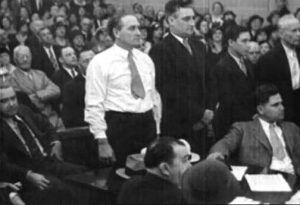
Albert Bates, in shirtsleeves, Harvey Bailey, Armon Shannon, and his father, Robert Shannon stand to be sentenced after they were found guilty.
On September 30, the jury returned a guilty verdict against Robert G. Shannon, Ora L. Shannon, Armon Shannon, Albert L. Bates, Harvey J. Bailey, Clifford Skelly, and Barney Berman. On October 7, 1933, Harvey J. Bailey, Albert L. Bates, R.G. Shannon, and Ora L. Shannon were each sentenced to life imprisonment, Armon Shannon to 10 years probation. Edward Barney Berman and Clifford Skelly were each sentenced to serve five years.
In the meantime, the Kellys were still at large. They, too, were tracked down and arrested in Memphis, Tennessee, on September 26, 1933. They were returned to Oklahoma City and were convicted and sentenced to life imprisonment on October 12, 1933.
Several other people were charged with harboring a fugitive. When the investigation and trials were complete, 21 people were convicted of various crimes with six life sentences and other sentences totaling 58 years, two months, and three days.
George “Machine Gun” Kelly was initially sent to the Federal Penitentiary in Leavenworth, Kansas. In August 1934, Kelly was transferred to Alcatraz after making threats to free himself and his wife from prison in time for the Christmas holidays. When he arrived at Alcatraz on September 4, 1934, he was among the first group of prisoners to be incarcerated there. In 1951 he was returned to the Federal Penitentiary in Leavenworth, Kansas, where he died of a heart attack on his 59th birthday on July 18, 1954. He is buried in Cottondale Cemetery in Cottondale, Wise County, Texas.
Kathryn Kelly was released from prison in Cincinnati, Ohio, in 1958. Her mother, Ora Shannon, was released the same year. Upon their release, the two lived quietly in Oklahoma City. Later, her mother was institutionalized at the Oklahoma County Home and Hospital in Oklahoma City, and Kathryn was given a job there as a bookkeeper. Ora Shannon died in 1980 at the age of 92. Kathryn Kelly died at the age of 81 in 1985. Both women are buried at the Tecumseh Cemetery near Oklahoma City, Oklahoma.
Robert “Boss” Shannon was pardoned by President Franklin Roosevelt in 1944 owing to ill health. He returned to Paradise, Texas, and died at a Bridgeport, Texas hospital on December 25, 1956.
Albert Bates died at Alcatraz on July 4, 1948. Harvey Bailey was paroled in 1961 but was re-arrested by Kansas authorities, who still wanted him for his 1933 prison break. He was paroled from the Kansas penitentiary in 1965 and spent his last years in Joplin, Missouri, working as a cabinet maker. He died on March 1, 1979, at the age of 91.
Thomas Holden was released from Alcatraz in 1948 and murdered his wife and her two brothers in a drunken brawl in Chicago, Illinois. He was subsequently captured in Beaverton, Chicago, and spent his remaining years in the State Penitentiary at Joliet, Illinois.
Francis Keating reportedly lived peaceably following his release from Alcatraz and is said to have died in Minneapolis, Minnesota, in 1978.
Today, Machine Gun Kelly is remembered, along with the likes of “Pretty Boy” Floyd, “Baby Face” Nelson, Bonnie Parker, and Clyde Barrow, as one of the criminals that made up the Midwest crime wave of the early 1930s.
© Kathy Alexander/Legends of America, updated November 2022.
Also See:
Sources:
Biography.com
Federal Bureau of Investigation
Geneaology.com
WikiTree

